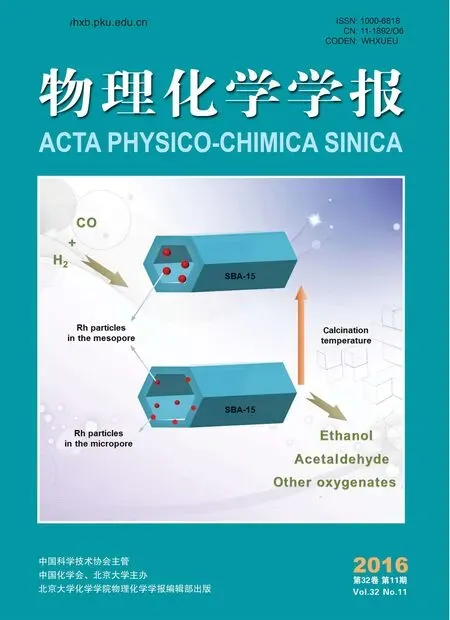铜掺氧化锌多孔纳米棒的水热合成及其光催化性能
王元有 周国强 张 龙 刘天晴,*
(1扬州大学化学化工学院,江苏省环境材料与环境工程重点实验室,江苏扬州225002;2扬州工业职业技术学院化工系,江苏扬州225127)
铜掺氧化锌多孔纳米棒的水热合成及其光催化性能
王元有1,2周国强1张 龙1刘天晴1,*
(1扬州大学化学化工学院,江苏省环境材料与环境工程重点实验室,江苏扬州225002;2扬州工业职业技术学院化工系,江苏扬州225127)
通过两步法合成铜掺杂的氧化锌纳米棒,通过X射线衍射(XRD)、扫描电子显微镜(FESEM)、透射电子显微镜(TEM)、X射线光电子能谱(XPS)和紫外-可见(UV-Vis)分光光谱等技术对系列样品进行了表征,研究并探索了铜掺杂的氧化锌纳米棒光降解染料罗丹明B(RhB)和气体乙醛的催化活性。通过对多孔Cu掺杂ZnO纳米棒光催化分解乙醛进行了评价。多孔Cu掺杂ZnO纳米棒(CZ-5)光催化剂具有最高的催化分解乙醛的能力,比其它多孔Cu掺杂ZnO纳米棒具有很高的催化活性。多孔Cu掺杂ZnO纳米棒光催化剂在室温下在可见光(435 nm)下照射16 h,5.50×10-4(φ,体积分数)的乙醛气体完全降解为二氧化碳(CO2)。多孔铜掺杂的氧化锌纳米棒光催化剂的光催化性能的改善主要归因于铜和氧化锌纳米棒之间的协同作用。这种改进的光催化协同作用归因于Cu掺杂ZnO的可见光吸收的延伸和光生电子空穴对的抗重组。
半导体;铜掺杂的氧化锌;纳米棒;光催化
Key Words:Semiconductor;Cu-doped ZnO;Nanorod;Photocatalysis
1 Introduction
Acetaldehyde(CH3CHO)is a major pollutant that causes sick house syndrome and is a common outdoor pollutant found in many industrial products,including paints,treated wood,solvents, plastics,and fabrics.The indoor environment plays an important role in human health,because people generally spend more than 80%of their time in indoors,which contributes a higher risk from inhalation of pollutants than outdoors.Furthermore,acetaldehyde is a colorless,flammable,widespread gas in air at room temperature.So people are mostly exposed to acetaldehyde by inhalation. Low-level exposure to acetaldehyde could cause damage to the human body,related symptoms such as eye and throat irritation, chest tightness and breath shortness.High-dose exposure increases the risk of acute poisoning,while prolonged exposure may lead to chronic toxicity and even cancer,Hence,it is necessary to identify and remove acetaldehyde from the indoor environment for improving indoor air quality and human being′s health.In addition,because of the increasing concern on CH3CHO in the indoor environment,the abatement of CH3CHO is of significant practical interest at low temperature,especially at room temperature.Many studies have been carried out on the abatement and removal of acetaldehyde from the atmosphere,and a number of effective methods have been developed.Among several methods used in the removal of acetaldehyde in an indoor environment,the most economical and simple way is photocatalytic removal of the acetaldehyde for indoor air purification.This method has many advantages,such as high removal efficiency,a low function temperature(room temperature),atmospheric pressure,a wide range of applications,simple operation of equipment,and no secondary pollution.Thus,photocatalytic technology is drawing attention as a way to get rid of acetaldehyde.Photocatalytic approach commonly uses semiconductor photocatalytic material.In Previous studies,A lot of semiconductors have been applied in photocatalytic for formaldehyde degradation,such as ZnO,CeO2, Ta2O5,InVO4,MnO2,TiO2,and Bi2O31-9.Doping a single metal or nonmetal into ultraviolet light-active titanium dioxide photocatalysts have been the most attractive strategies to design and develop efficient visible light active TiO2nanoparticle photocatalysts for decontamination of toxic organic compounds in polluted air and water,such as(Sr,N)/TiO210,(Ni,B)/TiO211,(La,N)/TiO212, (La,S)/TiO213,(Fe,C)/TiO214,(V,B)/TiO215,and(V,C)/TiO216, have been developed and investigated especially for environmental remediation purposes.To the best of the authors′knowledge,there are no reports on acetaldehyde degradation with Cudoped ZnO photocatalysts.photocatalytic degradation of organic pollutants has attracted great interest due to its unique features. Among various semiconductor materials,ZnO is one of the most promising candidates for the degradation of organic pollutants because of its low cost,environmental friendliness and wide band gap(3.37 eV).Various ZnO nanostructures were prepared and utilized as efficient photocatalysts for the photocatalytic degradation of various organic pollutants17-22.However,poor photon absorption of ZnO limits its application in visible light photocatalyst due to a wide band gap of 3.37 eV.In order to shift the optical absorption of ZnO into the visible region,one possible approach is to dope ZnO photocatalyst with various impurities.Cu is the best choice as impurity for ZnO due to the minimum size mismatch between Cu and Zn.A few methods have been used successfully to synthesize the Cu-doped ZnO nanostructures23-27. In spite of achievements in the synthesis of Cu-doped ZnO nanostructures,further exploration of some facile,mild,low-cost, and high-yield synthetic routes to manufacture tailored nanostructured materials is still desired.Astudy of a more complicated system will provide deeper insight into the development of a more practical catalyst applicable to a real contaminated target.The obtained Cu-doped ZnO nanostructures show remarkably enhanced photocatalytic performances for acetaldehyde degradation under simulated solar light irradiation,higher than those of pure ZnO materials.Furthermore,the photocatalytic activity enhancement mechanism of the Cu-doped ZnO nanostructures and the process of charge separation and transfer at the surface or interface were also discussed.Herein,we reported a simple and economical two step reactions to synthesize uniform Cu-doped ZnO nanorods,which displayed high visible light photodegradation activities for the degradation of RhB aqueous solution and acetaldehyde(CH3CHO)gas.
2 Experimental
2.1Materials
All the chemical reagents used in this work include sodium hydroxide(NaOH),H2O2(30%(w,mass fraction)),zinc nitrate hexahydrate(Zn(NO3)2·6H2O),copper nitrate trihydrate (Cu(NO3)2·3H2O),potassium hydrogen phthalate(KHC8H4O4), rhodamine B(RhB),acetaldehyde(CH3CHO),and ethanol (C2H5OH).All chemicals were analytically pure and were used as received without further purification.Deionized water was used throughout the experiment.All reagents were from Shanghai Chemicals Inc.,China.All reagents were analytically pure.
2.2Methods
A typical synthesis of precursor(zinc phthalate hydrate)is as follows:6 mmol Zn(NO3)2·6H2O was dissolved in 50 mL distilled water and then 6 mmol KHC8H4O4was put into the solution with stirring.After that,12 mmol NaOH was added into the above solution.Finally the mixed solution was transferred into a Teflonlined autoclave of 80 mL capacity and was filled up to 85%of the total volume with deionized water.After being sealed and heated at 120°C for 6 h,the autoclave was cooled to room temperature naturally.The resulting products were collected by centrifugation, washed with distilled water and ethanol for several times,and finally dried in vacuum at 70°C for 6 h.To obtain Cu doped precursor,similar procedure was performed under the same reaction condition except using 6 mmol Zn(NO3)2·6H2O and dif-ferent stoichiometric amounts of Cu(NO3)2·3H2O were added to the resultant mixed solution.Porous Cu-doped ZnO nanorods could be yielded when the precursors were heated in a muffle oven at 500°C for 2 h,respectively.Cu-doped ZnO nanorods were prepared for different Cu2+molar concentrations namely 1%,2%, and 5%,and were indexed as samples‘CZ-1’,‘CZ-2’,and‘CZ-5’,respectively.
2.3Characterization
The phase purity of the products was characterized by X-ray diffraction(XRD,German Bruker AXSD8 ADVANCE X-ray diffractometer)using a X-raydiffractometer with Cu Kαradiation (λ=0.15418 nm).Morphology information of theas-prepared particles was obtained on a Japan Hitachi S-4800 field emission scanningelectron microscope(SEM).Transmission electron microscope(TEM)images,highresolution transmission electron microscopy(HRTEM)images,high angle annulardark field (HAADF)images,and elemental mapping images were obtained on an American FEI Tecnai G2 F30 S-TWIN field-emission transmission electronmicroscopy(operated at 300 kV).Diffuse reflectance spectra(DRS)were measured using a UV-Vis spectrophotometer(Shimadzu,UV-2600)equipped with an integrating sphere unit(Shimadzu,ISR-2600 Plus).Fluorescence spectra were obtained using a photoluminescence spectrometer(JASCO,FP-8500).X-ray photoelectron spectra(XPS)were recorded on an ESCALAB 250Xi system(Thermo Scientific).
2.4Photocatalytic testing
RhB aqueous solution photodegradation evaluation test:the photocatalytic activities of as-prepared products were tested by degrading an organic dye,RhB in aqueous solution.Amixture of 60 mL 1×10-5mol·L-1RhB aqueous solution,5 mL H2O2(30% (w)),and 10 mg prepared samples were put in bottle with a capacity of 200 mL and stirred in the dark for 30 min.Then the mixture was continuously agitated throughout the experiment and irradiated by a 250 W Xe lamp,cut-off filter(>420 nm).After a given irradiation time,about 3 mL the mixture was withdrawn and immediately centrifuged.The photocatalytic degradation process of RhB was monitored by measuring its absorption with a UV-Vis spectrophotometer.
CH3CHO gaseous phase photo degradation evaluation test:0.1 g samples were spread on the bottom of a watch-glass.The watchglass was put and 125 mL 5.50×10-4(φ,volume fraction)acetaldehyde/pure air mixture gases were injected into the Tedlar bag (polyvinyl fluoride,As ONE Co.Ltd.).The bag was located in dark room for 2 h to ensure the adsorption equilibrium.Then the samples were irradiated under LED lamp(central wavelength of 435 nm)with 3 mW·cm-2light intensity.The concentration variation of acetaldehyde and CO2evolution were monitored by on-line gas chromatography(Agilent Technologies,3000AMicro-GC,TCD detector)equipped with OV1 and PLOT-Q columns.
3 Results and discussion
3.1XRD curves of as-synthesized samples
The crystal structures of the as-prepared precursor and the samples obtained after annealing were characterized via XRD (Fig.1).In Fig.1(a),it can be seen that all peaks of the precursor can be indexed to zinc phthalate hydrate Zn[C6H4(COO)2]·H2O. ZnO and Cu-doped ZnO nanorods were obtained after calcination of the precursor in air at 500°C(Fig.1(b)).It was found that all the samples exhibited the typical character of wurtzite hexagonal phase structure according to the standard JCPDS(36-1451)card. No any other impure diffraction peaks were detected,At low Cu2+concentration the local supersaturation is not achieved and hence Cu2+ions may be incorporated into ZnO lattice suggesting that Cu is highly dispersed in the sample,or they are too small to be detected.With further increase in the Cu2+concentration,new peak appearing at 2θ=38.6°was found when the molar content of Cu atoms was increased to 5%(x,molar fraction),which are attributed to(111)plane for the CuO crystalline structure.
3.2Component analysis and Barrett-Emmett-Tellertests of ZnO samples
To understand the component of these pure ZnO and Cu-doped ZnO samples clearly,the total amount of Cu in ZnO was determined by WDXRF and the results are shown in Table 1.It shows that each of the samples has similar composition and if contains Zn and Cu.Thus,it can be concluded that the as-synthesized samples are devoid of any other impurity atoms.It can also be found that the atomic ratio of Cu/Zn was to be about 0.000,0.009, 0.025,0.046,which is close to the experimental dopant concentration.
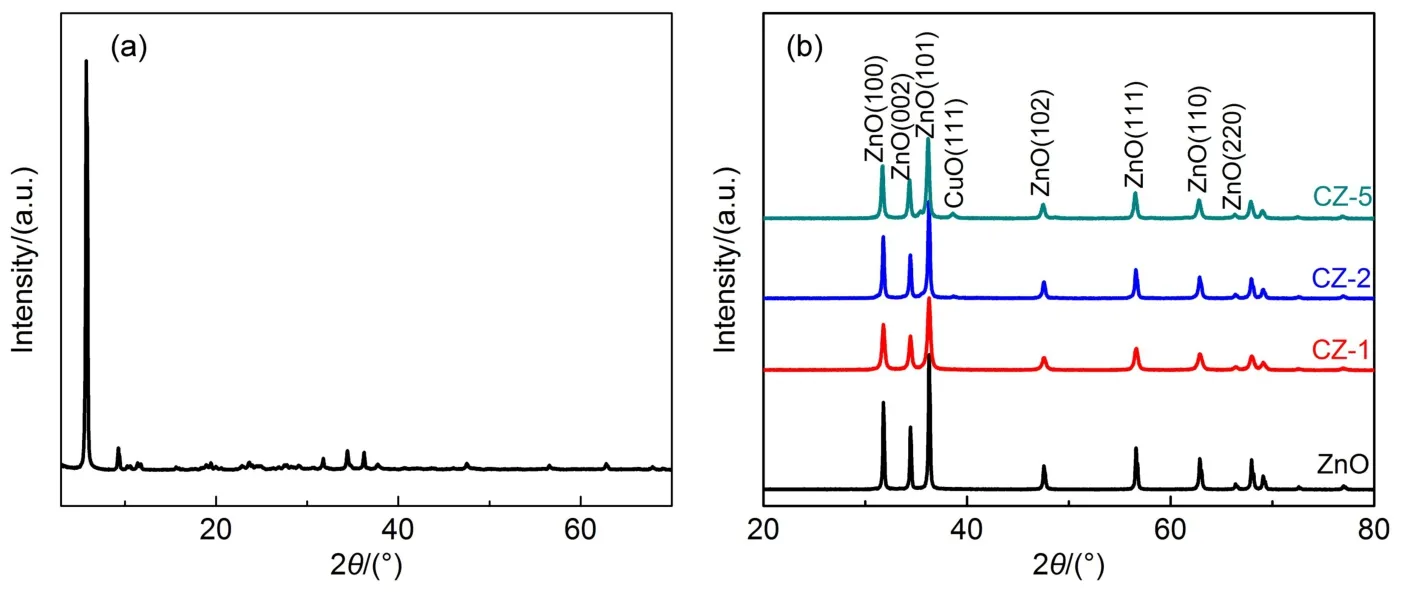
Fig.1 XRD patterns of(a)Zn[C6H4(COO)2]·H2O precursors,(b)ZnO and Cu-doped ZnO nanorods
Furthermore,the obvious changes can be seen in Barrett-Emmett-Teller(BET)and pore size of the as-synthesized pure ZnO and Cu-doped ZnO,which are shown in Table 1.Comparing with the specific surface area pore size of pure ZnO,the specific surface area of Cu-doped ZnO samples have been enlarged,which may be suitable for increasing the photocatalytic activity of the Cudoped ZnO samples.

Table 1 Elemental composition,pore size and BET of the as-synthesized samples
3.3FESEM and HRTEM images of the samples
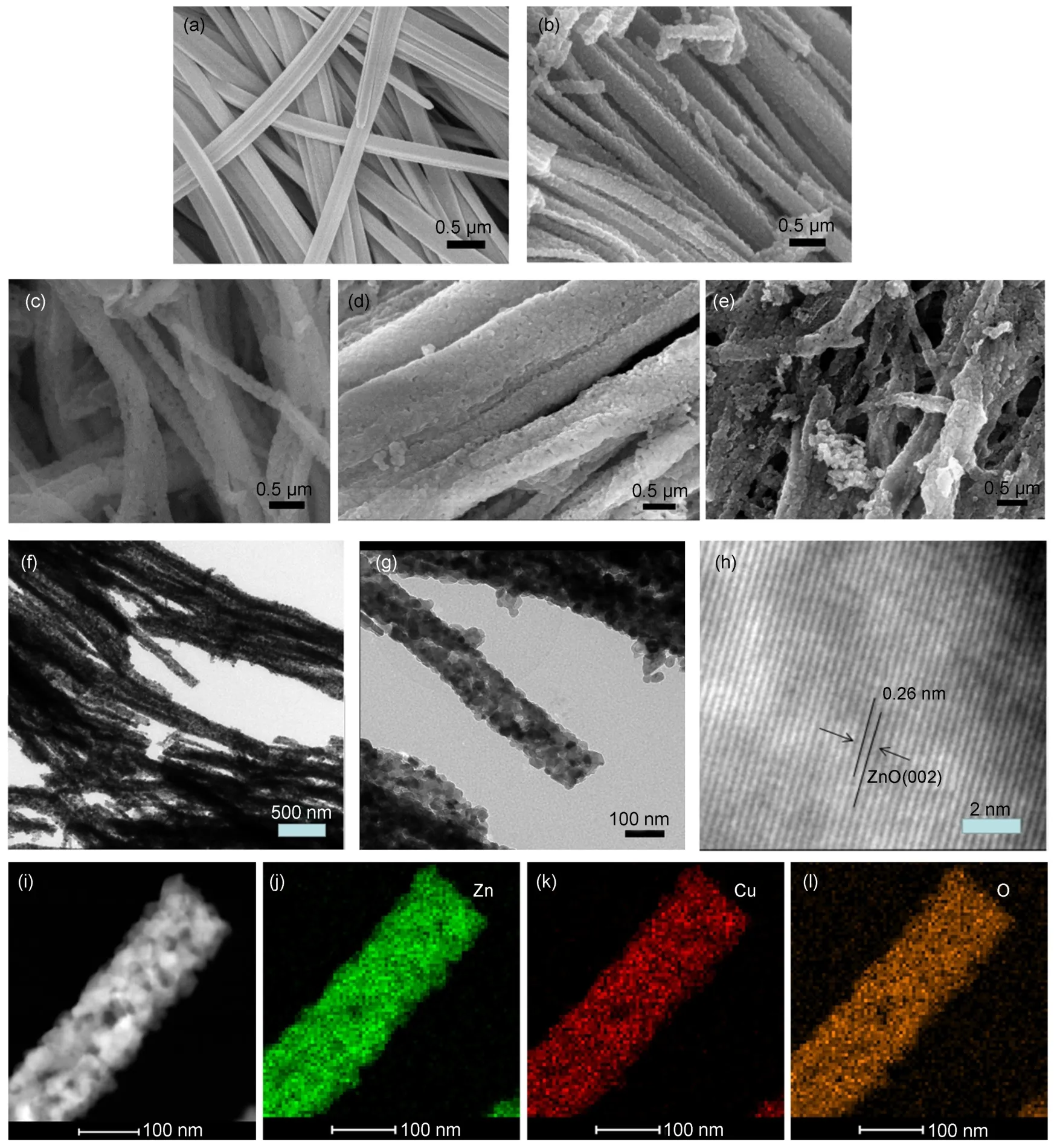
Fig.2 FESEM images of(a)Zn[C6H4(COO)2]·H2O precursor,(b)ZnO nanorods,and(c-e)Cu-doped ZnO nanorods(CZ-1,CZ-2,and CZ-5); (f,g)TEM images of Cu-doped ZnO nanorods;(h)HRTEM image of Cu-doped ZnO nanorods; (i-l)STEM image and elemental mapping of a single Cu-doped ZnO nanorod
The morphologies of the precursor and ZnO were investigated with SEM.Fig.2(a)shows the SEM images of the precursor.It can be seen that Zn[C6H4(COO)2]·H2O precursor much was obtained. The length of a single nanorod was approximately 3-5 mm and the diameter varied in the range between 70-150 nm.Compared with the precursor,the composition analyses of the 5%(x)Cudoped ZnO sample were characterized by HRTEM energy-dispersive X-ray spectroscopy(EDS)mapping(scanning model of HRTEM)using a FEI F30 microscope equipped with an EDAX energy EDS.High resolution scanning transmission electron microscopy-EDS(HRSTEM-EDS)mapping results in Fig.2(i-l) of as-synthesized 5%(x)Cu-doped ZnO sample revealed that the composition of the sample contains Cu,Zn and O.Thus,it can beconcluded that the as-synthesized 5%(x)Cu-doped ZnO sample were devoid of any other impurity.As-prepared samples(undoped ZnO and Cu-doped ZnO)after calcination in air possessed similar rod shape morphology(Fig.2(b)and Fig.2(c-e)).However,the surface of rods has become much rough.For Cu-doped ZnO(CZ-5),it looked like bead-like chains composed of lots of nanoparticles bound with each other along a definite direction from the TEM image(Fig.2(f)).And a lot of pores were found in the enlarge TEM image(Fig.2(g)).The porous structure on the ZnO nanorods would be the result of loss of volatile gases such as H2O and CO2during the heat treatment.The interplanar spacing of 0.26 nm in Fig.2(h)is equal to the bulk ZnO(002),indicating that the crystal lattice does not expand or contract.The STEM and elemental mapping images(Fig.2(i-l))further confirm that the Cudoped ZnO nanorods were prepared.Different colors indicate different elements:green,red,and orange refer to Zn,Cu,and O elements,respectively.
3.4UV-Vis diffuse reflectance spectra
The optical absorption spectra of undoped and Zn1-xCuxO(where x=0.0,0.010,0.02,0.05)samples by UV-DRS spectrum in the range of 200-800 nm were presented.From Fig.3(a),it can be seen that the excitonic absorption peak of undoped ZnO and Cudoped ZnO nanorods appear around 375 nm,which is the absorption edge of ZnO.The excitonic absorption peak of as prepared undoped and Cu doped samples become broad as the molar ratio increases.In addition,for Cu-doped ZnO nanorods,a broad absorption covers the range of 400-800 nm.This may be attributed to efficient harvesting of visible light by Cu-doping in ZnO and provides the possibility of enhancing visible light absorption28.Fig.3(b)shows the representative photoluminescence (PL)spectra of the as-prepared samples with the excitation wavelength of 325 nm at room temperature.There are two peaks in undoped ZnO:one is the UV near-band-edge(NBE)emission centered at 375 nm;the other is a broad green region centered at 580 nm.Compared with that of pure ZnO,the emission of Cudoped ZnO is dramatically reduced,It might also suggest that the green emissionoftheas-synthesizedCu-dopedZnO(CZ-5)samples may be attributed to oxygen vacancies defects at the surface or in the bulk.indicating the decreased recombination of photogenerated holes with the electrons in intrinsic or extrinsic defects after photo irradiation process,which will enhance the photocatalytic efficiency.Fig.3(c)shows a plot of(αhν)2vs hν,which gives an absorption edge energy that corresponds to the band gap (Eg).The band gaps of the Cu-doped ZnO products were estimated to be 3.16,3.01,2.97,and 2.92 eV,respectively.The effect of Cudoped ZnO products is clearly noted on its band gap.
3.5XPS spectra of the samples
To clarify the elemental composition and chemical state of the as-synthesized 5%(x)Cu-doped ZnO nanorods,XPS spectra were carried out with the binding energies calibrated using C 1s(284.8 eV),as shown in Fig.4.The peaks can be ascribed to Zn,O,C,and Cu(Fig.4(a))confirming the sample is prepared comparing to the only Zn,O,C elements present in the 5%(x)Cu-doped ZnO nanorods(Fig.4(b))as shown in Fig.4.Zn,O,Cu elements were found in Fig.4.Two strong peaks in Fig.4 center on 1020.9 and 1043.9 eV,which are in agreement with the binding energies of Zn 2p3/2and Zn 2p1/2,respectively.The Cu 2p binding energies of the as-prepared samples were 932.6 eV(Cu 2p3/2)and 952.2 eV(Cu 2p1/2),respectively,which also proved the existence of Cu2+in the as-synthesized Cu-doped ZnO sample.O 1s profile is asymmetric and can be fitted into two symmetrical peaks at 529.9 and 531.3 eV,which agrees well with the branched ZnO and the reported value for ZnO29,30.Therefore,the result of XPS further confirms that the samples are composed of ZnO and CuO.
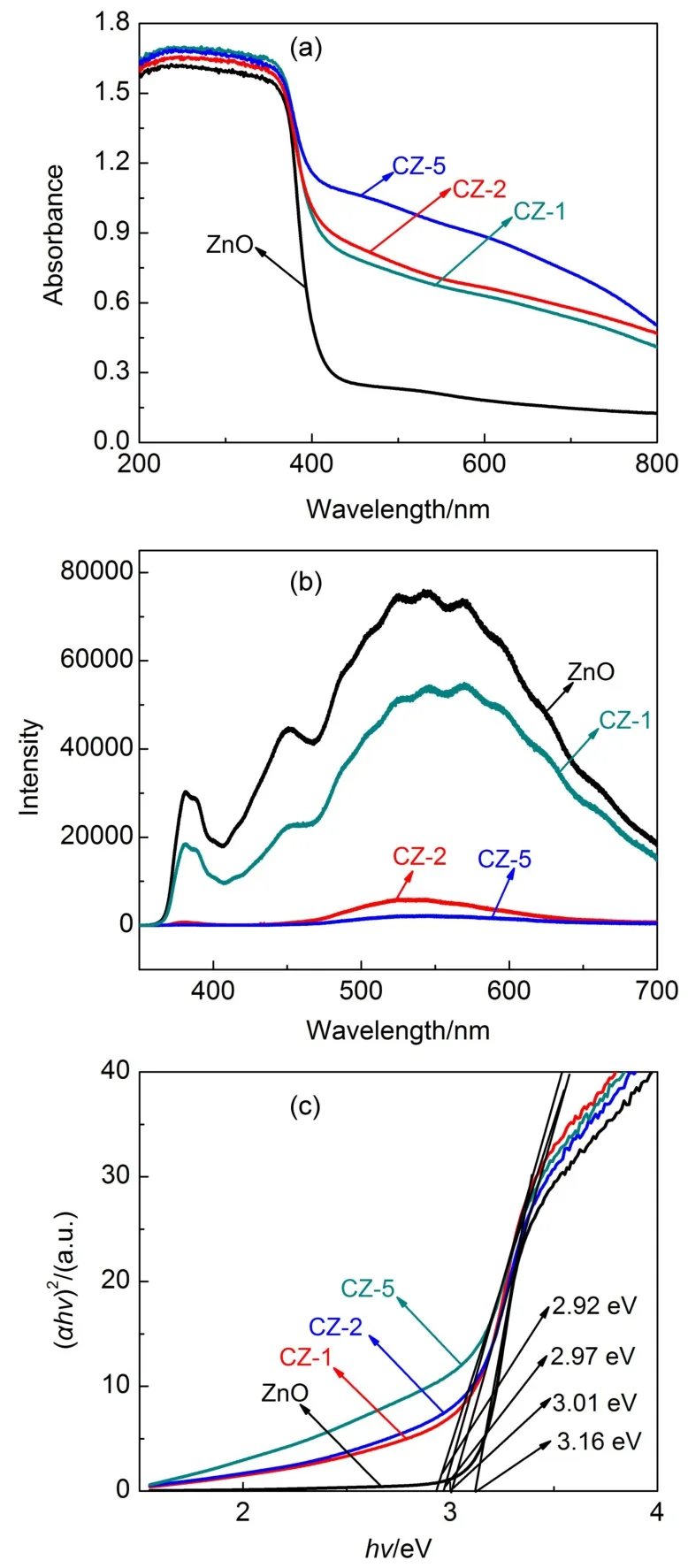
Fig.3 (a)DRS and(b)PLspectra of ZnO and Cu doped ZnO nanorods and(c)plots of(αhν)2vs hν for ZnO,CZ-1,CZ-2,and CZ-5
3.6Photocatalytic performance
Photocurrents for the as-synthesized Cu-ZnO and ZnO electrodes were also measured on a Zahner workstation(Zahner, German)with a LW405 light(10 mW·cm-2)as the accessory light source to investigate the electronic interaction between CuO andZnO(Fig.5).Generally,semiconductor photo catalysis involves the generation of electrons in the conduction band and holes in the valence band within a semiconductor upon light irradiation at energies equal to or greater than the band gap of the semiconductor.Subsequently,the utilization of photo excited charge carriers to initiate redox reactions with suitable substrates on the semiconductor surface.To further understand the heterojunction effect on the photocatalytic activity enhancement of CZ-5 nanorods,we carefully studied the photo induced charge transfer properties of the CZ-5 nanorods.It was clear that fast and uniform photocurrent responses were observed in both electrodes and the photoresponsive phenomenon was entirely reversible.Under visible light irradiation,It is known that the higher the photocurrent intensity,the more effective the separation of photo-induced carriers.The photocurrent density of the Cu-ZnO electrode was higher than that of the pure ZnO electrode(Fig.5).The photocurrent enhancement of the Cu-ZnO photocatalyst indicated an enhanced photoinduced electrons and holes separation when comparing with pure ZnO.

Fig.4 XPS spectra of the CZ-5(a)and the scan of(b)Cu 2p,(c)Zn 2p,and(d)O 1s
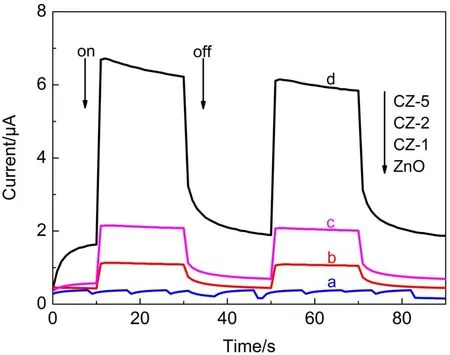
Fig.5 Transient photocurrent response for ZnO and Cu doped ZnO nanorods under visible light irradiation
The photocatalytic activities of as-fabricated products were evaluated by measuring CO2evolution form the photocatalytic decomposition of acetaldehyde.Fig.6(a,b)shows the time course of CO2liberation of samples with different of dopant concentrations.From Fig.6(a,b)we can conclude that the porous Cu-doped ZnO nanorods(CZ-5)photocatalyst shows the highest CO2generation concentration,which is higher activity than that of porous ZnO nanorods.When the dopant concentration is low (<0.01 mol),the as-fabricated samples show a low CO2liberation rate as in the case of pure ZnO.However,with increase in the concentration of the dopant,the CO2liberation rate rapidly improved,which demonstrated that a high content dopant is beneficial for enhancement of photocatalytic activities.When the content of dopant reached 0.05 mol,the fabricated sample showed the highest CO2liberation rate,and with further increase in concentration of the dopant,the CO2liberation rate decreased. Namely,5.50×10-4(φ)CH3CHO gas is fully degraded to CO2by this porous Cu-doped ZnO nanorods photocatalyst within 16 h at room temperature under 435 nm visible light irradiation.The photocatalytic performance improvement of the porous Cu-doped ZnO nanorods photocatalyst is mainly attributed its intimate interfacial contact between Cu and ZnO nanorods.This improvedphotocatalysis was attributed to the synergistic actions of Cudoped ZnO for the extension of visible light absorption and the anti-recombination of photogenerated electron-hole pairs,which are also well accordance with the PL analysis results in Fig.3(b). Therefore,many more photogenerated holes and electrons prefer to be involved in the photocatalytic reaction rather than be annihilated by the form of radiation.Meanwhile,porous Cu-doped ZnO nanorod is with good stability and high efficiency after photocatalytic reaction because this photocatalyst still retains 99% photocatalytic activity after three CH3CHO degradation recycles (Fig.6(e)).Besides,the photodegradation experiments of RhB aqueous solution were further carried out to investigate the universality of this photocatalyst.Obviously,RhB dyes photodegradation results in solution in Fig.6(c)present a similar tendency with CH3CHO ones in gaseous phase.In summary,porous Cudoped ZnO nanorod has excellent photodegradation performance in RhB dye and CH3CHO gas under visible light irradiation.It is clear that optimal Cu doping has increased the photocatalytic degradation efficiency in comparison to undoped ZnO sample. Without any photocatalyst,the degradation of RhB hardly occurs when subjected to the visible light irradiation for 120 min.

Fig.6 Photocatalytic performance evaluation curves of the as-prepared photocatalysts
It is well known that the photocatalytic decomposition of organic pollutants accords with the pseudo first-order kinetic model. The degradation rate constant was calculated from the experimental data using Eq.(1)31,

where,kris the degradation rate constant,and t is the degradation time.The value of degradation rate constant krfor RhB dyes was calculated from the slope of the kinetics plot obtained by plotting the natural logarithm of concentration ratio,ln(C0/C),vs the ir-radiation time,t,as shown in Fig.6(d),respectively.The kinetic parameters like degradation rate constant kr,half-life value(t1/2), and linear coefficient(r2)calculated from the kinetics plots are given in Table 2.

Table 2 Degradation parameter of RhB by the photocatalysts
The rate constant for the 5%(x)Cu-doped ZnO sample was k= 3.9×10-2min-1.which was larger than that of the reported Cudoped samples(k=3.229×10-2min-1)32and that of the pure ZnO samples.These results reveal that Cu doping enhances the photocatalytic efficiency of pure ZnO under visible light.
Both H2O2and Cu-doped ZnO nanorods play an important role in the degradation of RhB.Studies on oxidative degradation of organic dyes with H2O2have been reported previously using CuO as catalyst33.The degradation proceeds by an adsorption-oxidationdesorption mechanism34,35.Several free radical species are believed to be responsible for the degradation of dyes,including HO·, HOO·,or O2·.
In the current work,similar processes may also be involved. Firstly,RhB and H2O2are adsorbed on the surface of Cu-doped ZnO nanorods.Secondly,H2O2is decomposed into free radical species,such as HO·,HOO·,or O2·as induced by the highly active catalyst.The nascent free radical species have high oxidative ability and cause destructive oxidation of the organic dye. Thirdly,small molecules from the dye degradation are desorbed of Cu-doped ZnOnanorods surface,and the catalyst is recovered36.
Moreover,it can also be seen in BET,UV-Vis spectra and potocurrent spectra of the as-synthesized ZnO samples that the enhanced photocatalytic activity of Cu-doped ZnO nanorods can also be attributed to enlarged surface area,higher excitonic peaks and enhanced photoinduced electrons and holes separation of the Cu-doped ZnO sample.
The possible schematic diagram for Cu-doped ZnO photocatalytic degradation of RhB dye and CH3CHO gas under visible light irradiation is shown in Scheme 1.
The proposed mechanism for the photocatalytic decomposition of organic pollutants by Cu-doped ZnO nanorods can be described as follows:

In fact,photocatalysis is a complicated process,which is associated with not only the structure-related physical properties,but also structure-related catalytic processes.The possible schematic diagram for Cu-doped ZnO photocatalytic degradation of RhB dye and CH3CHO gas under visible light irradiation is shown in Scheme 1.The possible scheme can be seen in the follow:
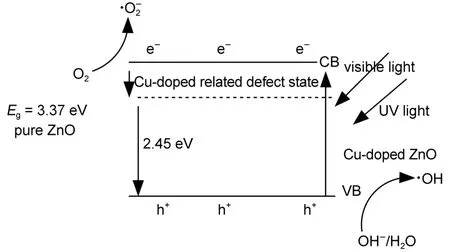
Scheme 1 Proposed photocatalytic mechanism of the porous Cu-doped ZnO nanorod
It is generally accepted that,when semiconductor materials are irradiated by UV light or visible light with a photon energy(hν) greater than their band gap energies,an electron(e-)in the valence band(VB)can be excited to the conduction band(CB)with the simultaneous generation of a hole(h+)in the VB,so the electrone hole pairs will appear37-39.
A suitable scavenger can provide to trap the electron or hole, which is prevented recombination and made subsequent redox reaction.Herein,Cu ions substitute in ZnO lattices sever as photogenerated electron trappers to restrain the recombination of electrons and holes.In this process,the electrons at the trapping states can absorbed O2molecules or dissolved oxygen to produce superoxide radical anions(·O2-).In addition,the photo-generated holes can be trapped by the Cu or Zn-related defect state(such as interstitial site of Cu(Cui))and will be further transformed into hydroxyl radicals(·OH).The free radicals·O2-and·OH produced in the reactions are regarded as strong oxidants to decompose organic pollutants or acetaldehyde(CH3CHO).
4 Conclusions
In summary,we reported Cu-doped ZnO nanorods that were synthesized through a two-step method.The products were characterized by XRD,FESEM,HRTEM,PL,and UV-Vis.The photocatalytic activity was explored by degradation of RhB dye and CH3CHO gas.The photocatalytic results show that doping of Cu into ZnO can enhance the photocatalytic efficiency of ZnO under visible light irradiation.Consequently,Cu-doped ZnO is a promising material for practical application in photocatalytic materials.
(1) Ai,Z.H.;Huang,Y.;Lee,S.C.;Zhang,L.Z.J.Alloy.Compd. 2011,509,2044.doi:10.1016/j.jallcom.2010.10.132
(2) Guo,Q.;Zhou,C.Y.;Ma,Z.B.;Ren,Z.F.;Fan,H.J.;Yang,X. M.Acta Phys.-Chim.Sin.2016,32,28.[郭 庆,周传耀,马志博,任泽峰,樊红军,杨学明.物理化学学报,2016,32,28.] doi:10.3866/PKU.WHXB201512081
(3) Liao,Y.C.;Xie,C.S.;Liu,Y.;Chen,H.;Li,H.Y.;Wu,J.Ceram.Int.2012,38,4437.doi:10.1016/j.ceramint.2012.03.016
(4) Tian,H.;He,J.H.;Liu,L.L.;Wang,D.H.;Hao,Z.P.;Ma,C. Y.Microporous Mesoporous Mat.2012,151,397.doi:10.1016/j. micromeso.2011.10.003
(5) Yang,L.P.;Liu,Z.Y.;Shi,J.W.;Zhang,Y.Q.;Hu,H.;Shang, W.F.Sep.Purif.Technol.2007,54,204.doi:10.1016/j. seppur.2006.09.003
(6) You,Y.;Zhang,S.Y.;Wan,L.;Xu,D.F.Appl.Surf.Sci.2012, 258,3469.doi:10.1016/j.apsusc.2011.11.099
(7) Zhang,L.;Fu,H.;Zhang,C.;Zhu,Y.J.Solid State Chem.2006, 179,804.doi:10.1016/j.jssc.2005.12.003
(8) Zhou,J.;Mullins,D.R.Surf.Sci.2006,600,1540.doi:10.1016/ j.susc.2006.02.009
(9) Zhu,Y.;Yu,F.;Man,Y.;Tian,Q.;He,Y.;Wu,N.J.Solid State Chem.2005,178,224.doi:10.1016/j.jssc.2004.11.015
(10) Sakatani,Y.;Ando,H.;Okusako,K.;Koike,H.;Nunoshige,J.; Takata,T.;Kondo,J.N.;Hara,M.;Domen,K.J.Mater.Res. 2004,19,2100.doi:10.1557/JMR.2004.0269
(11) Zhao,W.;Ma,W.;Chen,C.;Zhao,J.;Shuai,Z.J.Am.Chem. Soc.2004,126,4782.doi:10.1021/ja0396753
(12) Sakatani,Y.;Nunoshige,J.;Ando,H.;Okusako,K.;Koike,H.; Takata,T.;Kondo,J.N.;Hara,M.;Domen,K.Chem.Lett. 2003,32,1156.doi:10.1246/cl.2003.1156
(13) Li,X.K.;Ma,D.D.;Zheng,Y.P.;Zhang,H.;Ding,D.;Chen, M.S.;Wan,H.L.Acta Phys.-Chim.Sin.2015,31,1753.[李晓坤,马冬冬,郑燕萍,张 宏,丁 丁,陈明树,万惠霖.物理化学学报,2015,31,1753]doi:10.3866/PKU.WHXB201507091
(14) Bu,Y.Y.;Chen,Z.Y.RSC Adv.2014,4,45397.doi:10.1039/ C4RA06641C
(15) Bettinelli,M.;Dallacasa,V.;Falcomer,D.;Fornasiero,P.; Gombac,V.;Montini,T.;Romano,L.;Speghini,A.J.Hazard. Mater.2007,146,529.doi:10.1016/j.jhazmat.2007.04.053
(16) Yang,X.;Cao,C.;Hohn,K.;Erickson,L.;Maghirang,R.; Hamal,D.;Klabunde,K.J.Catal.2007,252,296.doi:10.1016/ j.jcat.2007.09.014
(17) Akpan,U.G.;Hameed,B.H.J.Hazard.Mater.2009,170,520. doi:10.1016/j.jhazmat.2009.05.039
(18) Hayata,K.;Gondalb,M.A.;Khaleda,M.M.;Ahmedc,S.; Shemsi,A.M.Appl.Catal.A:Gen.2011,393,122. doi:10.1016/j.apcata.2010.11.032
(19) Chen,S.F.;Zhao,W.;Liu,W.;Zhang,S.J.Appl.Surf.Sci. 2008,255,2478.doi:10.1016/j.apsusc.2008.07.115
(20) Rehman,S.;Ullah,R.;Butt,A.M.;Gohar,N.D.J.Hazard. Mater.2009,170,560.doi:10.1016/j.jhazmat.2009.05.064
(21) Xu,C.;Cao,L.;Su,G.;Liu,W.;Qu,X.;Yu,Y.J.Alloy.Compd. 2010,497,373.doi:10.1016/j.jallcom.2010.03.076
(22) Dindar,B.;Içli,S.J.Photochem.Photobiol.A:Chem.2001, 140,263.doi:10.1016/S1010-6030(01)00414-2
(23) Yu,J.Y.;Zhuang,S.D.;Xu,X.Y.;Zhu,W.C.;Feng,B.;Hu,J. G.J.Mater.Chem.A 2015,3,1199.doi:10.1039/c4ta04526b
(24) Liang,G.F.;Hu,L.W.;Feng,W.P.;Li,G.D.;Jing,A.H.Appl. Surf.Sci.2014,296,158.doi:10.1016/j.apsusc.2014.01.065
(25) Xue,H.;Chen,Y.;Xu,X.L.;Zhang,G.H.;Zhang,H.;Ma,S. Y.Phys.E 2009,41,788.doi:10.1016/j.physe.2008.12.017
(26) Kamalianfar,A.;Halim,S.A.;Azak,K.Ceram.Int.2014,40, 3193.doi:10.1016/j.ceramint.2013.09.123
(27) Guo,Q.;Minton,T.K.;Yang,X.M.Chin.J.Catal.2015,36, 1649.[郭 庆,Minton,T.K.,杨学明.催化学报,2015,36, 1649.]doi:10.1016/S1872-206760935-4
(28) Rajneesh,M.;Karthikeyan,K.;Sang-Jae,K.Solid State Commun.2012,152,375.doi:10.1016/j.ssc.2011.12.008
(29) Sahu,D.;Panda,N.R.;Acharya,B.S.;Panda,A.K.Ceram.Int. 2014,40,11041.doi:10.1016/j.ceramint.2014.03.119
(30) Yang,M.Q.;He,J.H.J.Colloid Interface Sci.2011,355,15. doi:10.1016/j.jcis.2010.11.022
(31) Li,X.J.;Sheng,J.Y.;Chen,H.H.;Xu,Y.M.Acta Phys.-Chim. Sin.2015,31,540.[李晓金,盛珈怡,陈海航,许宜铭.物理化学学报,2015,31,540.]doi:10.3866/PKU.WHXB201501131
(32) Pawar,R.C.;Choi,D.H.;Lee,J.S.;Lee,C.S.Mater.Chem. Phys.2015,151,167.doi:10.1016/j.matchemphys.2014.11.051
(33) Yang,M.;He,J.J.Colloid Interface Sci.2011,355,15. doi:10.1016/j.jcis.2010.11.022
(34) Zhang,Y.;Chen,L.;Zheng,Z.;Yang,F.Solid State Sci.2009, 11,1265.Doi:10.1016/j.solidstatesciences.2009.03.018
(35) Segal,S.R.;Suib,S.L.;Foland,L.Chem.Mater.1997,9,2526. doi:10.1021/cm9702934
(36) Zhang,W.;Yang,Z.;Wang,X.;Zhang,Y.;Wen,X.;Yang,S. Catal.Commun.2006,7,408.doi.org/10.1016/j. catcom.2005.12.008
(37) Chu,F.H.;Huang,C.W.;Hsin,C.L.;Wang,C.W.;Yu,S.Y. Ye,P.H.;Wu,W.W.Nanoscale 2012,4,1471.doi:10.1039/ c1nr10796h
(38) Liu,Y.;Zhao,N.;Gao,W.RSC Adv.2013,3,21666. doi:10.1039/c3ra42902d
(39) Macwan,D.P.;Dave,P.N.;Chaturvedi,S.J.Mater.Sci.2011, 46,3669.doi:10.1007/s10853-011-5378-y
Synthesis and Photocatalytic Characterization of Porous Cu-Doped ZnO Nanorods
WANG Yuan-You1,2ZHOU Guo-Qiang1ZHANG Long1LIU Tian-Qing1,*
(1Jiangsu Key Laboratory of Environmental Material and Environmental Engineering,School of Chemistry and Chemical Engineering,Yangzhou University,Yangzhou 225002,Jiangsu Province,P.R.China;2Department of Chemical Engineering,Yangzhou Polytechnic Institute,Yangzhou 225127,Jiangsu Province,P.R.China)
A two-step method was developed for the selective synthesis of porous ZnO nanorods(undoped and Cu doped):first,Zn[C6H4(COO)2]·H2O and Cu doped Zn[C6H4(COO)2]·H2O nanorods were synthesized via the hydrothermal reaction of Zn(NO3)2·6H2O,NaOH,KHC8H4O4,and Cu(NO3)2·3H2O at 120°C for 6 h;second, porous undoped and doped ZnO nanorods were obtained by thermal decomposition of the precursors in air at 500°C for 2 h,respectively.The porous ZnO nanorods were characterized by X-ray diffraction(XRD),scanning electron microscopy(SEM),transmission electron microscopy(TEM),X-ray photoelectron spectroscopy(XPS), and ultraviolet-visible(UV-Vis)spectroscopy.The photocatalytic degradation of rhodamine B(RhB)aqueous solution shows that the porous Cu-doped ZnO nanorods have the highest photodegradation performance with visible light and acetaldehyde(CH3CHO)gas degradation.These results are because of the special interface structures of the catalysts and fast separation of its photogenerated charge carriers.These favorable photocatalytic properties of the doped microstructures demonstrate their potential for degradation of wastewater and aldehydes.
O643
10.3866/PKU.WHXB201608304
Received:June 27,2016;Revised:August 30,2016;Published online:August 30,2016.
*Corresponding author.Email:tqliu@yzu.edu.cn;Tel:+86-514-87975244.
The project was supported by the National Natural Science Foundation of China(21505118),Natural Science Foundation of Jiangsu Province,China (BK2150438),Jiangsu Key Laboratory of Environmental Material and Environmental Engineering,China(K13065),PriorityAcademic Program Development of Jiangsu Higher Education Institutions,Senior Visiting Scholar Program of Jiangsu Higher Vocational College,China(2015FX089), and Qing Lan Project of Jiangsu Province,China.
国家自然科学基金(21505118),江苏省自然科学基金(BK2150438),江苏省环境材料与环境工程重点实验室开放课题(K13065),高职院校高级访问学者计划(2015FX089)和江苏省“青蓝工程”资助项目

